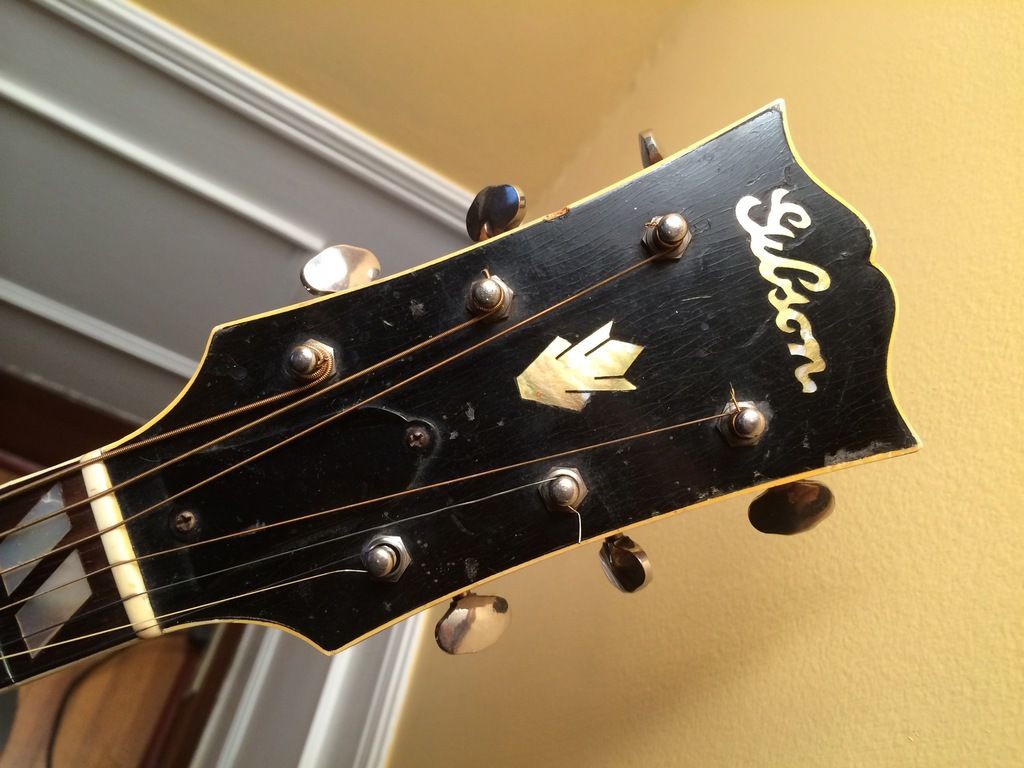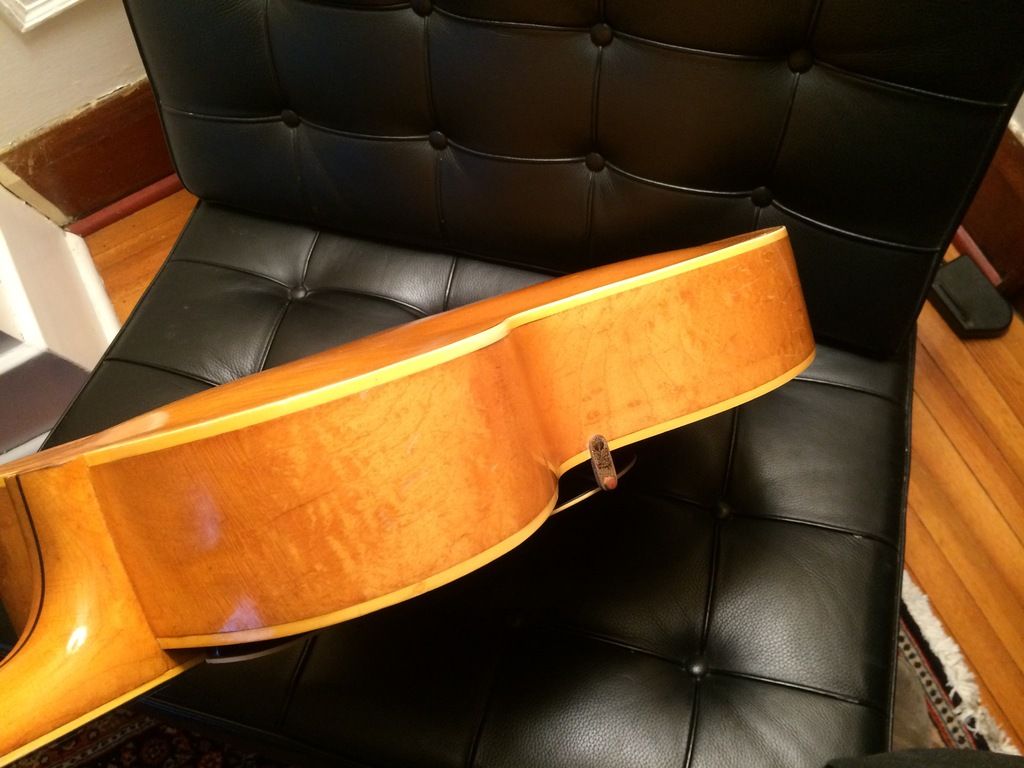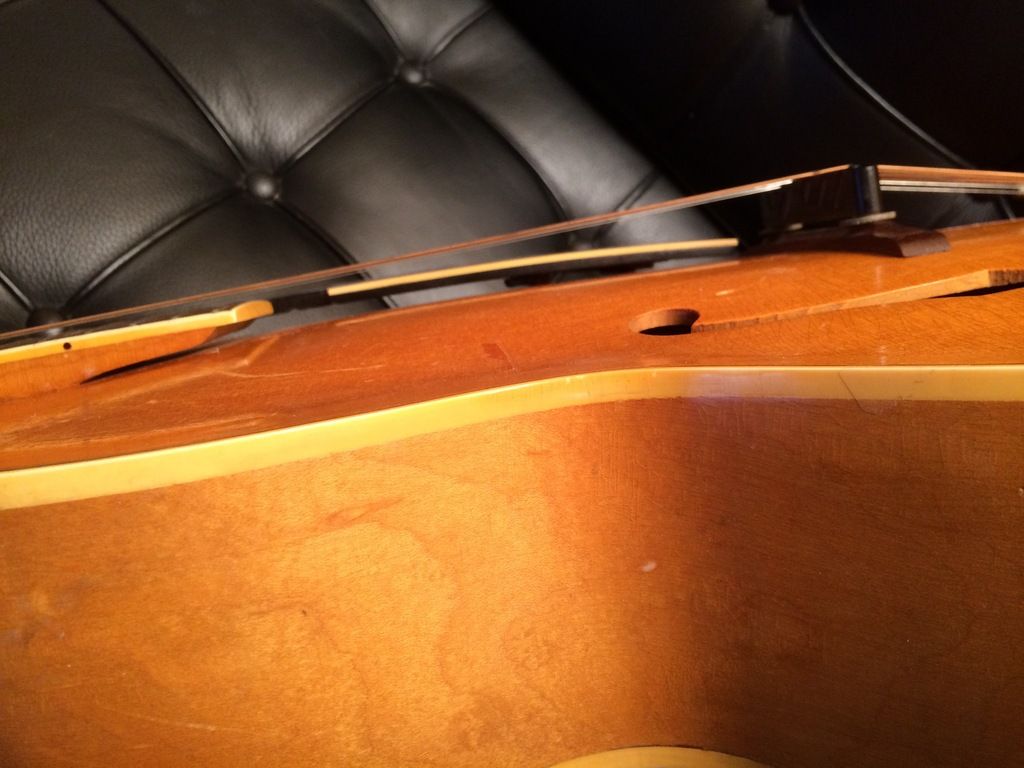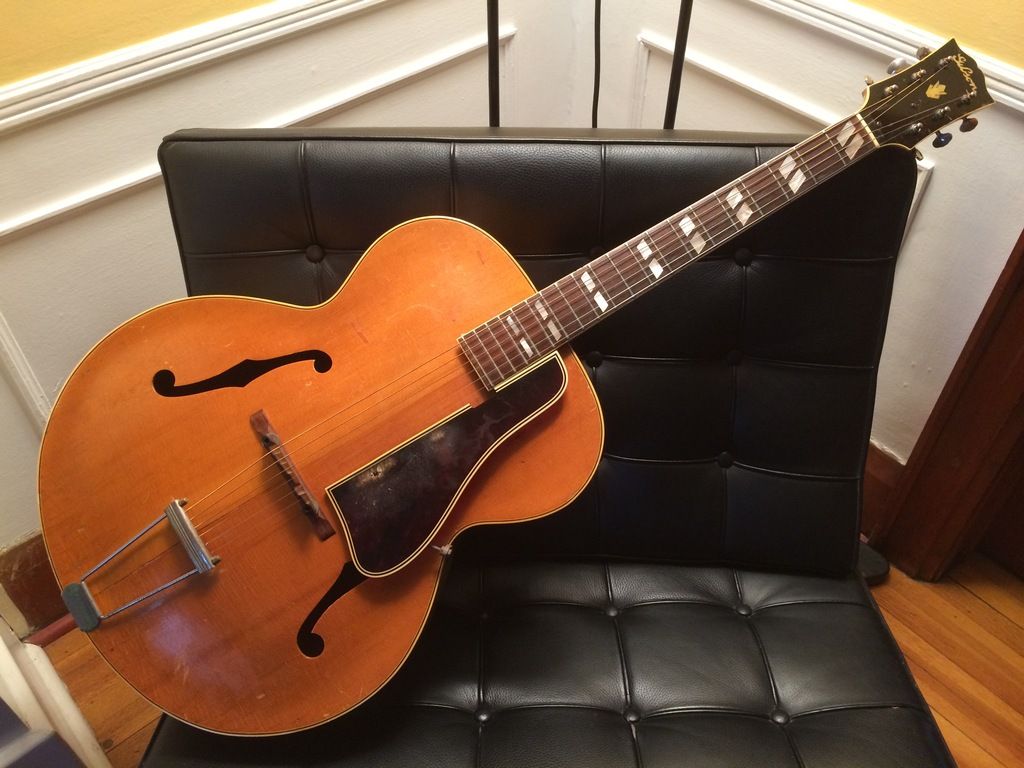-
Congratulation, it's looks good and if you love it, it is good!
I replaced the skinny frets on that L4 I just got with heavier frets too... big difference.
- JoeLast edited by AlohaJoe; 05-22-2015 at 05:27 PM.
-
05-21-2015 07:15 PM
-
Wow. 1944. The stories that Guitar can tell. Beautiful Guitar.
Also, that is the largest geode I've ever seen. Amazing.
L7's are great guitars. I am surprised that aren't one of the most more sought after guitars. Gibson was doing great things before any company. And they continue to do so, still to this day.
JD
-
I think it looks amazing, too. You did good with the refin - made it look correct. If it had non-original paint and bad areas when you bought it, then you saved her dignity. There's something very special about a 30's or 40's Gibson archtop. Play on!
-
I hear the recent ones made in Montana are fantastic also.
-
And with 24.75" scale length which sort of robs the Bozeman, Montana L-7C of its essential L-7 character. I hear that it is cross-braced too.
 Originally Posted by vinnyv1k
Originally Posted by vinnyv1k
-
I have found that the long-scale and parallel bracing really robbed the post-'38 L-7/L-5 guitars of their essential Advanced L-7/L-5 short-scale, x-braced character. Thankfully, the Bozeman reissue fixed that problem.
 Originally Posted by Jabberwocky
Originally Posted by Jabberwocky

-
Yes, interestingly, it is a rare case of Gibson revisiting a classic and arguably correcting something for the better. The short scale, X-braced late 1930s Advanced archtops are some of the best Gibson ever made IMHO. It's kinda cool that they reprised the guitar and brought back those characteristics rather than the post-1939 version.
-
Wait a minute….is it possible that both designs are great, yet…different?
And that the pre-Advanced 16" Gibson archtops are also great, yet different?
Can such a thing be? ……..
….Nah. My guitar is red-hot, your guitar ain't doodly-squat.
But seriously, that '44 L-7 is sweet - the refinish looks great.
Post a picture of the original tailpiece, please.Last edited by Hammertone; 05-23-2015 at 09:58 AM.
-
Thanks RP, it was only the neck that got the treatment and the luthier that did it has done lots of old Gibson's and Epiphone's. It is an education to do the research on these old instruments, but having someone that considers knowing about and working on them his core competency and loves doing it is rare. It definitely requires love, since he makes little money doing it. I gave him a lot more that he asked for after he did the work because of the good karma it generates. I would do this again in a heartbeat. Now I feel guilty about not playing my Campellone and Trenier that I've spent considerably more to buy. There is just something about that old Gibson sound that is so powerful. You can find these old girls and put a few sheckles into them and 'bam', you end up with a very cool guitar for less that what you'd pay for a perfect used boutique guitar. It's changed my view on archtops. But I don't think it's possible without knowing and having a good relationship with a great luthier, not one of these machine shop guys that does guitars by the hundreds.
 Originally Posted by rpguitar
Originally Posted by rpguitar
-
-
Here's mine with old tailpiece:
-
Bought this from Hammertone a while back, but just have it back from the luthier (refret).
are pictured below.
Nice transaction, and he threw in a nice Gibson brown and pink case.
I got a detailed description from him at the time, but his ad is long gone, so I have to do som of this from memory. I suspect he will drop in on the thread and correct anything I have wrong.
It believe that he got it from the original owner. There are some (disclosed) issues, that I will note in a separate post. It is parallel braced. It plays fine, but the bridge had to come down all the way to make that happen; I am going to send it back to the luthier to get myself a little bit more adjustment room.
I have decided to keep this one strictly acoustic, so I put on a set of TI AC111s, which are very close in gauge to my normal JS112. They go 11 14 19 27 36 50, The E and B are brass coated steel, the ADG are polished bronze flatwound, and the low E is polished bronze roundwound. The round string has silk and steel in it. The tension is similar to the JS112s, stiffer than labellas or classical strings, but less stiff than regular acoustic strings. They play like jazz flats but sound like acoustic strings. Highly recommended.
-
NICE! The Gibson L-7 guitars are great old jazz boxes. All the ones I've played are serious rhythm tools. You can chonk out four-to-the-bar rhythm chords all day long on an L-7. Bill Haley, who was a good rhythm guitarist--in addition to being a singer--actually preferred the L-7 to the Super-400 that he was often pictured with. In an old interview I read (late-60s/early-70s) Haley described the L-7 as the greatest rhythm guitar of all time.
Enjoy.
-
Sorry for my photo skills; I try to do better ones later. Here are the issues:
Hard to see in the photo, but there are outlines showing that other tuners have been on the guitar. The ones on it are vintage and correct.
The cosmetics are a little ugly where the pickguard was mounted. The pickguard was included, but it has started to outgas, and has been removed (I usually remove pickguards anyway).
There is a center seam separation repair, apparently done long ago. It has been touched up a bit. The tailpiece is not original, and is not correct, but vintage and functional. No playing wear on the neck; perhaps refinished? Hammertone says he got the guitar from the original owner.
-
Nice. Glad you grabbed it from Hammertone. I wondered where that went. Many of those vintage L7's are some of the finest old gibsons ever, IMHO. No bias here, since I own a '44, but my luthier told me it's the best he's ever heard, and he's worked on a boatload of them.
Incredible players, that's for sure.
One suggestion, asked the Luthier about resetting the neck. Most guitars, especially of that vintage, would benefit from it, and that solves many of the bridge height problems, which significantly effect the intonation btw. It's standard maintenance on them, and not terribly expensive to do. You would not regret it.
Thanks for sharing,
Happy New Year!
Steve
-
A solid tailpiece would cover it up completely.
Benedetto Archtop Tailpiece | stewmac.com
-
Very nice no pedals. The tailpiece you're looking for would be great on her. Though the one you have caught my eye. I really liked the aged look of it. I recently picked up an L7c and she's a joy. So light and comfortable. Congrats!
-
This picture might be a little sharper.
No wooden tailpiece for this guitar ... or neck reset (it is pretty dialed in; I just want some adjustment room).
Now come on, somebody have a 30s art deco tail piece in their parts bin they can let go for a reasonable price? (fat chance). Actually, I thought about emailing Slaman, since he crafts similar ones for his ES-250 copies. I hear that he is a nice fellow, but that seems like a long shot ...
Kind of came full circle on this one. In the early 80s, back in the days when guys typically had one guitar, I had a 1936 X braced L7 with picture frame inlays, airline tweed case, and a dearmond model 1000. Paid $600 for it at McKenzie River Music.Last edited by nopedals; 01-01-2016 at 05:45 PM.
-
Did the Period Correct Fisher receiver and AR speakers come with it ?

-
Interesting L5 style back of the headstock. Did all the blonde L7s have that?
-
My basement hideout has a Fisher 500-B, AR XA table, and AR6s, and no TV. And lots of LPs.
The top piece of the bridge is quite a bit darker than the bottom piece, and looks unusually tall to me, so it might not be original. It can't be screwed down to less than one inch off the top of the guitar, and I think that 7/8 inch would be more standard. So I think that shaving a bit off the bottom of the top piece might give me a more normal range of adjustment.
Another oddity. It does not say L7 anywhere on the guitar; the part of the label where the style would be printed is pretty unreadable, but if I stare at it long enough, it looks like L5 (which of course the guitar is not).
-
After December 7, '41, Gibson's production was dictated by labour and materials management issues because of the war. But their Advanced archtop guitars had already changed significantly in 1938, IMO largely because of the highly competitive, long-scale, parallel-braced, larger archtops from Epiphone.
Gibson's response was to adopt the longer scale and parallel bracing, and to change the shape of the carve for its top and back plates. As well, Gibson introduced the 17" ES-250 in '38/'39, which evolved into the ES-300 by 1940, essentially an electrified L-7N. This particular L-7 is an excellent example that reflects some of the changes at the time - long scale, parallel bracing, different top carve, laminated back. It could have originally come with any of several tailpieces that Gibson was using at the time, but the Waverly is most likely not one of them. The original tuners could have been Grovers or Klusons and this guitar has had both types on in its history. The ones on the guitar are correct.
I got the guitar from the daughter of the original owner - he bought it new in Philadelphia or NYC and it went west to Arizona when he retired to the Copper State with his family. He certainly played it a great deal, judging by the wear on the original case, and it sounds fabulous. I think he took very good care of the guitar.
The top part of the bridge is as I received it - I think it's original and perhaps reflects the state of Gibson QC at the time. If it had been replaced due to wear at a much later date, it would typically show much more defined contours. Perhaps it is a replacement and the original had an accident very early in its life - we'll never know. The bottom is original. As far as the label goes, it could be blank - I'm not sure where in the production process Gibson would have sent this to the ES-300 table instead of the L-7N table. Probably the same table, heh.
The top is not thick and survived without any cracks over the years. The center seam separation could be made invisible by a skilled luthier, but I wouldn't bother. My guess is that it is an artifact of its life in arid Arizona.
I like that the f-hole edges aren't painted (when did painted edges start? Anyone?) and that it never had a strap button installed near the heel.
Oh, and it probably sounds better acoustically than most 17" arch tops made by Gibson since 1960. Way better.
Pix from my ad:







Last edited by Hammertone; 01-02-2016 at 04:40 AM.
-
My '44 has butter bean shaped tuners
and painted f-holes
The photos are before the neck reset and refret. You can maybe see the bridge adjustment is all the way down in the photo and the frets where shot. I had the neck refinished while it was off to protect it. Someone must have tried it with a paint brush at some point, you can see paint on the tuners, and the neck had almost all of the lacquer worn off from use and it was down to bare maple and walnut. It's beautiful now. It's had a million songs played on it, up and down the neck.
These old L7's are freaking incredible. You're lucky. Congratulations.Last edited by skykomishone; 01-02-2016 at 01:51 AM.
-
It does say L5 if you stare at it long enough. It is not auto-suggestion either.
If you don't mind the 3-rhomboids trapeze tailpiece as seen on the later ES-175s, you could use one of those and have a wooden maple insert made. That would go some way towards covering that repaired seam. Someone posted a Heritage maple pickguard for $20 recently with a notch for a humbucker in it.
It looks like a very nice L7 that could be made to play well with a luthier's help.
Congratulations. Any new guitar day is a very good day.Last edited by Jabberwocky; 01-02-2016 at 03:15 AM.
-
Congrats nopedals. Looks like a great piece of history in your hands!
I had question about your string recommendation. A while ago I bought a set of TI SB112s but when I tried to put them on my acoustic archtop the D string was way too short and I had to abandon the set :-( that was a bummer. Are there no string length issues here with the AC 111s? And will they work with a magnetic pickup?




 Reply With Quote
Reply With Quote







Ibanez AF207 7-string on reverb
Yesterday, 11:54 PM in For Sale